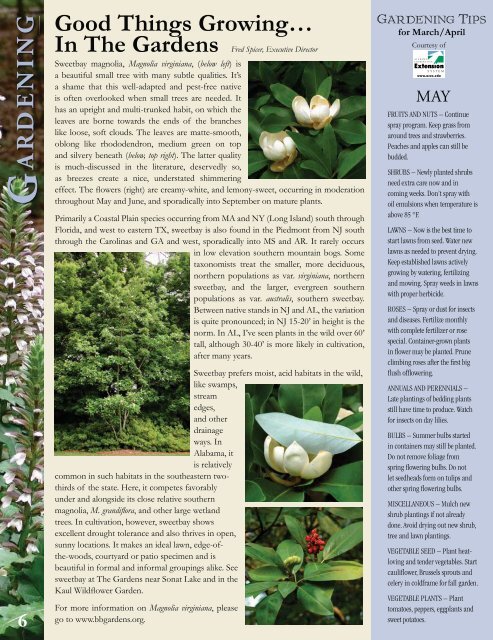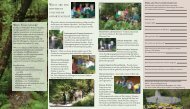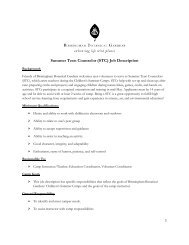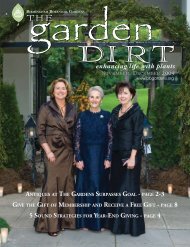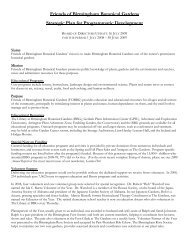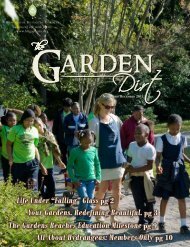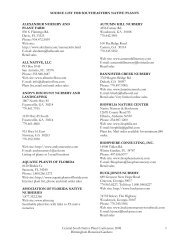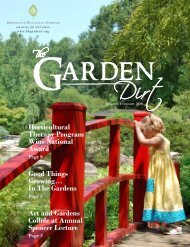Member Trip Members-only Class - Birmingham Botanical Gardens
Member Trip Members-only Class - Birmingham Botanical Gardens
Member Trip Members-only Class - Birmingham Botanical Gardens
You also want an ePaper? Increase the reach of your titles
YUMPU automatically turns print PDFs into web optimized ePapers that Google loves.
G ARDENING<br />
6<br />
Good Things Growing…<br />
In The <strong>Gardens</strong> Fred Spicer, Executive Director<br />
Sweetbay magnolia, Magnolia virginiana, (below left) is<br />
a beautiful small tree with many subtle qualities. It’s<br />
a shame that this well-adapted and pest-free native<br />
is often overlooked when small trees are needed. It<br />
has an upright and multi-trunked habit, on which the<br />
leaves are borne towards the ends of the branches<br />
like loose, soft clouds. The leaves are matte-smooth,<br />
oblong like rhododendron, medium green on top<br />
and silvery beneath (below, top right). The latter quality<br />
is much-discussed in the literature, deservedly so,<br />
as breezes create a nice, understated shimmering<br />
effect. The flowers (right) are creamy-white, and lemony-sweet, occurring in moderation<br />
throughout May and June, and sporadically into September on mature plants.<br />
Primarily a Coastal Plain species occurring from MA and NY (Long Island) south through<br />
Florida, and west to eastern TX, sweetbay is also found in the Piedmont from NJ south<br />
through the Carolinas and GA and west, sporadically into MS and AR. It rarely occurs<br />
in low elevation southern mountain bogs. Some<br />
taxonomists treat the smaller, more deciduous,<br />
northern populations as var. virginiana, northern<br />
sweetbay, and the larger, evergreen southern<br />
populations as var. australis, southern sweetbay.<br />
Between native stands in NJ and AL, the variation<br />
is quite pronounced; in NJ 15-20’ in height is the<br />
norm. In AL, I’ve seen plants in the wild over 60’<br />
tall, although 30-40’ is more likely in cultivation,<br />
after many years.<br />
Sweetbay prefers moist, acid habitats in the wild,<br />
like swamps,<br />
stream<br />
edges,<br />
and other<br />
drainage<br />
ways. In<br />
Alabama, it<br />
is relatively<br />
common in such habitats in the southeastern twothirds<br />
of the state. Here, it competes favorably<br />
under and alongside its close relative southern<br />
magnolia, M. grandiflora, and other large wetland<br />
trees. In cultivation, however, sweetbay shows<br />
excellent drought tolerance and also thrives in open,<br />
sunny locations. It makes an ideal lawn, edge-ofthe-woods,<br />
courtyard or patio specimen and is<br />
beautiful in formal and informal groupings alike. See<br />
sweetbay at The <strong>Gardens</strong> near Sonat Lake and in the<br />
Kaul Wildflower Garden.<br />
For more information on Magnolia virginiana, please<br />
go to www.bbgardens.org.<br />
Gardening Tips<br />
for March/April<br />
Courtesy of<br />
www.aces.edu<br />
MAY<br />
FRUITS AND NUTS – Continue<br />
spray program. Keep grass from<br />
around trees and strawberries.<br />
Peaches and apples can still be<br />
budded.<br />
SHRUBS – Newly planted shrubs<br />
need extra care now and in<br />
coming weeks. Don’t spray with<br />
oil emulsions when temperature is<br />
above 85 °F.<br />
LAWNS – Now is the best time to<br />
start lawns from seed. Water new<br />
lawns as needed to prevent drying.<br />
Keep established lawns actively<br />
growing by watering, fertilizing<br />
and mowing. Spray weeds in lawns<br />
with proper herbicide.<br />
ROSES – Spray or dust for insects<br />
and diseases. Fertilize monthly<br />
with complete fertilizer or rose<br />
special. Container-grown plants<br />
in flower may be planted. Prune<br />
climbing roses after the first big<br />
flush offlowering.<br />
ANNUALS AND PERENNIALS –<br />
Late plantings of bedding plants<br />
still have time to produce. Watch<br />
for insects on day lilies.<br />
BULBS – Summer bulbs started<br />
in containers may still be planted.<br />
Do not remove foliage from<br />
spring flowering bulbs. Do not<br />
let seedheads form on tulips and<br />
other spring flowering bulbs.<br />
MISCELLANEOUS – Mulch new<br />
shrub plantings if not already<br />
done. Avoid drying out new shrub,<br />
tree and lawn plantings.<br />
VEGETABLE SEED – Plant heatloving<br />
and tender vegetables. Start<br />
cauliflower, Brussels sprouts and<br />
celery in coldframe for fall garden.<br />
VEGETABLE PLANTS – Plant<br />
tomatoes, peppers, eggplants and<br />
sweet potatoes.


